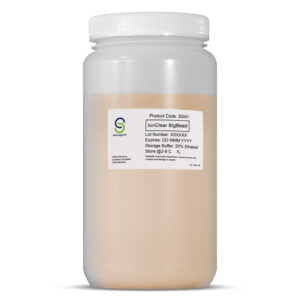Table 1. Resin Characteristics
| Bead Material | Agarose |
| Bead Percentage | 4% |
| Bead Size | 60-160 µm |
| Crosslinking | Highly Crosslinked Agarose (Superflow 4 Matrix) |
| Flow Rate 1
| >23 mL/min (686 cm/h) @ 1.6 cm x 20cm column |
| Protein Binding Capacity | >50 mg/mL |
| pH Stability | 2-14 |
|
Storage Temperature | 2-8oC
|
| Storage Buffer | 20% Ethanol
|
| Metal Leaching | Negligible Nickel Leaching (<0.5%)
|
| Form | Slurry |
| Chemical Stability 2 | 1mM EDTA, 20mM DTT, 1M NaOH, 6M Guanidine-HCl,
8M Urea. The use of primary amines (Tris, glycine,
etc.) can weaken binding affinity and should not be
utilized. |
| Physical Stability 2 | Negligible volume variation due to changes in pH or
ionic strength. |
1Linear flow rate = volumetric flow rate (cm3/h)/column cross-sectional area (cm2)
2Data refer to the coupled product, provided that the ligand can withstand the pH or chemical environment. Please note the following: pH stability, long term refers to the pH interval where the medium is stable over a long period of time without adverse effects on its subsequent chromatographic performance. pH stability, short term refers to the pH interval for regeneration and cleaning procedures.
Nickel NTA Chelating Superflow 4
Note: Chelating agents such as EDTA or citrate buffers can strip the Nickel ions from the resin. Avoid using these except for elution. The resin optimally binds at neutral to slightly basic pH (7-8).
Before you start:
1. Measure the required amount of suction-dried resin.
2. Wash the resin in a Buchner funnel or empty column with 5 bed volumes of DI water.
3. Remove the excess water by gentle suction and transfer the resin into a beaker or flask.
4. Determine Imidazole concentration for binding buffer, lower concentration gives higher yield but lower purity.
Buffers:
1. Storage Buffer: 20% Ethanol
2. Binding Buffer: 20 mM Sodium Phosphate buffer with 0.5 M NaCl, 20-40 mM Imidazole, pH 7-8
3. Alternative Binding Buffer: Tris-HCl (Tris may reduce binding affinity)
4. Elution Buffer: 20 mM Sodium Phosphate, 0.5 M NaCl, 500 mM (dependent on target protein) Imidazole
5. Alternative Elution Buffer: 10 mM EDTA
Protocol:
1. Wash the resin with at least 5 bed volumes of DI Water.
2. Equilibrate the washed resin in a column with 5-10 column volumes of binding buffer at 50-150 cm/h.
3. Load desired histidine-tagged protein sample onto the column and resin.
4. Pour binding buffer through the column and collect the flow-through. Measure absorbance of flow-through.
5. Elute with elution buffer using a stepwise or linear gradient and measure absorbance of eluent liquid.
6. Wash resin with 10-20 bed volumes of DI water to remove addition/unchelated metal ions.
7. Suction dry resin to remove residual water.
8. Place Nickel NTA Chelating Superflow 4 in 0.5 bed volumes of 20% ethanol.
9. Store resin at 2-8 °C.
Storage:
Nickel NTA Chelating Superflow 4 (cat#937410SF4) is supplied in 20% ethanol. Store at 2-8 °C. Do not freeze. Do not expose the resin to acidic or basic conditions (unless it is prescribed in the instructions).
For technical service email info@sterogene.com or call (760) 929-0455
To Download Instructions for use:
Instructions for Use for Product Code: 937410SF4 Nickel NTA Chelating Superflow 4






